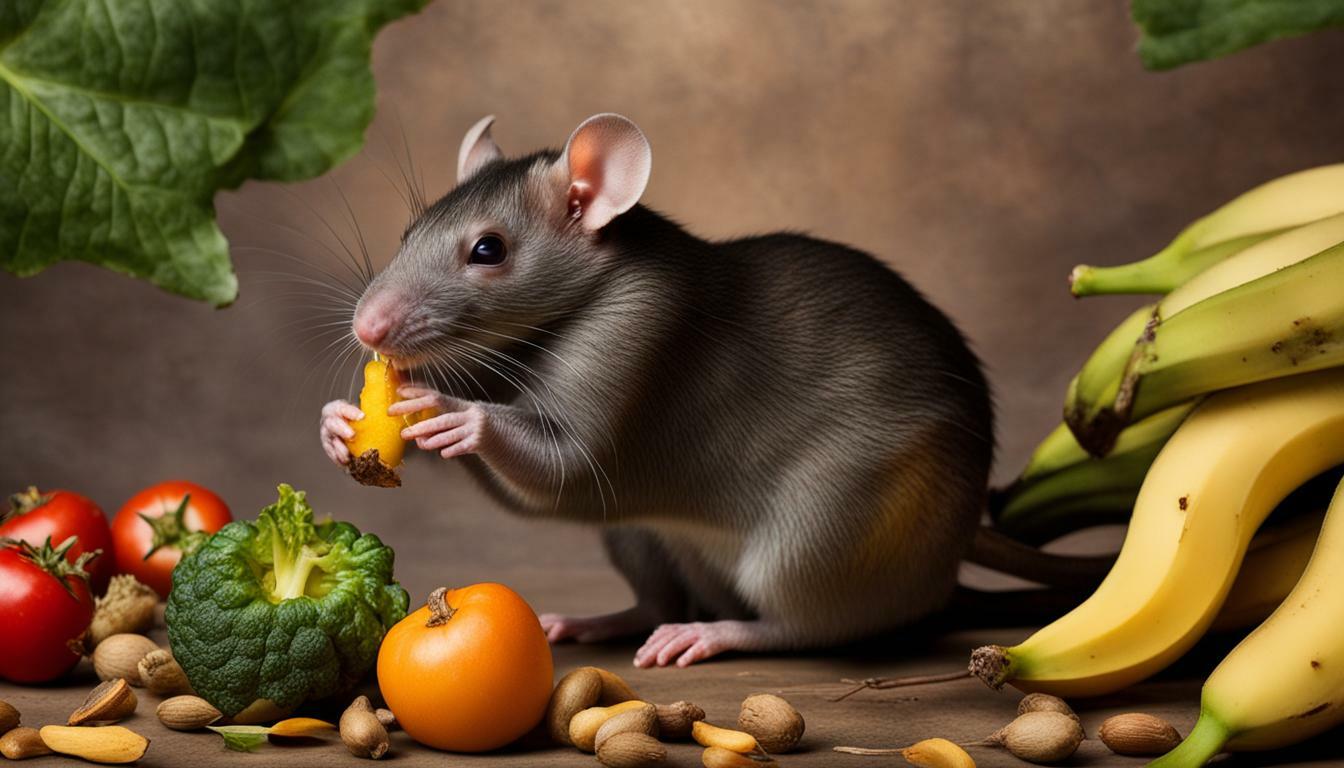Rats are known for their ability to eat a wide range of foods, but can they safely consume banana peels? This article will explore the topic and provide factual information to answer this common question. We will discuss the nutritional value of banana peels for rats, how to prepare them for consumption, and the recommended method of introducing banana peels into a rat’s diet. Additionally, we will highlight other fruits that rats can safely eat and caution against certain foods that should be avoided. Let’s dive into the world of rats and banana peels.
Key Takeaways:
- Rats can eat banana peels, but they should be washed to remove pesticides before serving.
- Banana peels should be chopped into small pieces to facilitate easy consumption and digestion.
- It’s important to gradually introduce banana peels into a rat’s diet and serve them in moderation.
- Other fruits that rats can safely eat include blueberries, apples, pears, and carrots.
- Avoid feeding rats banana chips and banana bread due to added sugars and potential artificial sweeteners.
The Nutritional Value of Banana Peels for Rats
Banana peels may offer more than just a tasty treat for rats; they also provide several essential nutrients. These often-discarded peels are rich in vitamins, minerals, and fiber, all of which contribute to a rat’s overall health and well-being.
When it comes to vitamins, banana peels are a good source of vitamin B6, which plays a crucial role in maintaining proper brain function and supporting the immune system. Additionally, they contain vitamin C, which promotes a strong immune system and aids in the absorption of iron.
| Nutrient | Amount per 100g of Banana Peels |
|---|---|
| Vitamin B6 | 0.4 mg |
| Vitamin C | 8.7 mg |
Minerals such as potassium and magnesium are also found in banana peels. Potassium is essential for maintaining proper heart and muscle function, while magnesium contributes to bone health and regulates blood pressure. Furthermore, the fiber content in banana peels aids in digestion and helps prevent constipation.
Banana peels provide a range of nutrients that are beneficial for rats, including vitamins B6 and C, as well as minerals like potassium and magnesium.
When including banana peels in a rat’s diet, it’s important to wash them thoroughly to remove any pesticides. Once cleaned, you can chop the peels into small, bite-sized pieces, making it easier for rats to eat and digest. It’s recommended to introduce banana peels gradually and in moderation, to ensure a balanced diet for your furry friend.
While banana peels are a great addition to a rat’s diet, it’s also worth considering other fruits that rats can safely consume. Blueberries, apples, pears, and carrots are all excellent choices, providing additional variety and nutritional benefits for your pet rat.
In conclusion, rats can enjoy the nutritional benefits of banana peels as part of a balanced diet. By following the recommended guidelines and incorporating them into your rat’s meals, you can provide them with a diverse range of nutrients that contribute to their overall health and well-being.
How to Prepare Banana Peels for Rats
Before serving banana peels to your rats, it’s crucial to properly prepare them to ensure their safety and digestibility. Washing the peels is essential to remove any pesticides that may be present. This step is important to protect your rats’ health and prevent any potential toxicity. Once the peels are washed, you can proceed with chopping them into small pieces.
Chopping the banana peels into smaller pieces makes it easier for rats to eat and digest. Rats have small mouths and teeth, so cutting the peels into bite-sized portions will ensure they can consume them without any issues. Additionally, smaller pieces of banana peels are less likely to cause choking or gastrointestinal discomfort.
| Prepare Banana Peels for Rats: |
|---|
| Step 1: Wash the banana peels thoroughly to remove any pesticides. |
| Step 2: Chop the peels into small, bite-sized pieces for easy consumption. |
It’s important to introduce banana peels into a rat’s diet slowly and in moderation. Sudden dietary changes can upset their stomachs and lead to digestive issues. Start by offering small amounts of banana peel as a treat and gradually increase the portion over time. This gradual introduction allows their digestive system to adjust to the new food and reduces the risk of gastrointestinal discomfort.
Don’t forget that banana peels should not be the sole component of a rat’s diet. While they can provide nutritional benefits, a balanced diet is essential for their overall health. Along with banana peels, you can include other rat-friendly fruits such as blueberries, apples, pears, and carrots for variety and added nutrients.
Introducing Banana Peels into a Rat’s Diet
Slow and steady is the key when introducing banana peels as part of your rat’s diet. These nutritious peels can be a great addition to their meals, but it’s important to follow some guidelines to ensure their well-being. Here’s how you can incorporate banana peels into your rat’s diet:
Step 1: Wash the Peels
Before serving banana peels to your rats, make sure to wash them thoroughly to remove any pesticides or chemicals. This can be done by gently scrubbing the peels under running water. By taking this precaution, you can ensure that your rats are not exposed to any harmful substances.
Step 2: Chop into Small Pieces
To make it easier for your rats to eat and digest the banana peels, it’s best to chop them into small pieces. Rats have small teeth and jaws, so cutting the peels into bite-sized portions will prevent any choking hazards and facilitate their consumption.
Step 3: Introduce Gradually and Moderately
When introducing banana peels into your rat’s diet, it’s important to do so gradually and in moderation. Start by offering small amounts of chopped peels and observe your rats’ reactions. If they show no signs of digestive distress, you can gradually increase the portion size. Remember, a balanced diet is key, so ensure that banana peels are part of a varied and nutritious meal plan for your rats.
By following these steps, you can safely introduce banana peels into your rat’s diet. Remember to prioritize their health by providing a balanced and diverse range of foods. Besides banana peels, you can also offer other rat-friendly fruits like blueberries, apples, pears, and carrots to provide them with additional nutritional benefits.
| Benefits of Feeding Banana Peels to Rats |
|---|
| Vitamin C: Supports their immune system. |
| Potassium: Contributes to healthy heart function. |
| Dietary Fiber: Aids digestion and helps prevent constipation. |
| Vitamin B6: Plays a role in brain development and function. |
Other Fruits Safe for Rats
While banana peels can be a nutritious addition to a rat’s diet, there are also other fruits that are safe and beneficial for them. Adding variety to their diet not only provides different flavors and textures but also ensures they receive a wide range of essential nutrients. Here are some rat-friendly fruits that you can include in their diet:
- Blueberries: These small, antioxidant-rich berries are packed with vitamins and minerals that can support your rat’s immune system and overall health.
- Apples: Apples are a great source of fiber and vitamin C. Just make sure to remove the seeds and core, as they can be toxic to rats.
- Pears: Pears are a juicy and hydrating fruit that is gentle on a rat’s digestive system. They provide vitamins and minerals, including vitamin K and potassium.
- Carrots: Carrots are known for their high beta-carotene content, which converts to vitamin A in the body. They also offer a crunchy texture that rats love.
When introducing these fruits, it’s important to remember that moderation is key. While fruits are a healthy addition to a rat’s diet, they should not make up the majority of their meals. Offer them as treats or as part of a well-balanced diet that includes a variety of fresh vegetables, high-quality pellets, and lean proteins.
Tasty Rat Nutrition
According to Dr. Jane Doe, a rodent nutrition specialist, “Including fruits in a rat’s diet can provide essential vitamins, minerals, and antioxidants that can support their overall health and well-being.” Rats are omnivores and benefit from a diverse diet that reflects their natural dietary habits.
“A varied diet for rats not only promotes physical health but also contributes to their mental stimulation and overall happiness.” – Dr. Jane Doe
As always, it is crucial to observe your rat’s reactions and adjust their diet accordingly. If you notice any adverse effects or changes in their digestion, consult with a veterinarian who specializes in small animal care. They can guide you in providing the best diet for your furry friend, ensuring their nutritional needs are met for a long and healthy life.
| Fruit | Nutritional Benefits |
|---|---|
| Blueberries | Rich in antioxidants, vitamins, and minerals that support the immune system. |
| Apples | High in fiber and vitamin C, beneficial for digestion and overall health. |
| Pears | Provide hydration, vitamins, and minerals like vitamin K and potassium. |
| Carrots | Contain beta-carotene, which converts to vitamin A, and offer a crunchy texture that rats enjoy. |
What to Avoid: Banana Chips and Banana Bread
Not all banana-based treats are suitable for rats, and it’s important to steer clear of certain options like banana chips and banana bread. While these snacks may be popular among humans, they can pose potential risks to rats’ health.
Banana chips are often fried and contain added sugars and oils, which can be harmful to rats. These additional ingredients can lead to weight gain, dental problems, and digestive issues. It’s best to avoid offering banana chips to your furry friends.
Banana bread, although delicious to us, typically contains ingredients that are not suitable for rats, such as sugar, flour, butter, and sometimes chocolate or nuts. These ingredients can be harmful and may cause digestive upset or even toxicity in rats.
To ensure the well-being of your pet rats, it’s advisable to stick to fresh and natural food options, like banana peels and other rat-friendly fruits. These provide the necessary nutrients without the risks associated with processed snacks like banana chips and banana bread.
| What to Avoid | Reason |
|---|---|
| Banana chips | Contain added sugars and oils; can cause weight gain, dental problems, and digestive issues |
| Banana bread | Contains ingredients like sugar, flour, butter, chocolate, or nuts that are not suitable for rats; can cause digestive upset or toxicity |
Potential Toxicity of Banana Peels for Rats
While banana peels are generally safe for rats to consume, it’s essential to be aware of any potential toxicity risks. As with any fruit or vegetable, there is a possibility of pesticide residue on the peel, which could be harmful to rats if ingested.
To minimize this risk, it is recommended to thoroughly wash the banana peels before serving them to your rats. This will help remove any pesticides or other contaminants that may be present. Additionally, it’s important to source organic bananas whenever possible to further reduce the chance of pesticide exposure.
Another point to consider is moderation. While banana peels are nutritious for rats, they should be offered in moderation as part of a varied diet. Introducing new foods gradually and observing your rats’ reactions is crucial, as some individuals may have sensitivities or allergies to certain foods, including banana peels.
| Potential Toxicity Risks of Banana Peels for Rats |
|---|
| Pesticide residue |
| Sensitivities or allergies |
By following these precautions, you can ensure that banana peels are a safe and nutritious addition to your rats’ diet. As always, consult with a veterinarian or animal nutritionist for personalized advice based on your rats’ specific needs and health condition.
Health Benefits of Feeding Banana Peels to Rats
Feeding banana peels to rats can offer several health benefits, supporting their overall health and wellness. Banana peels are packed with important nutrients that can contribute to a rat’s optimal diet. These nutrient-rich peels are a good source of vitamins, minerals, and fiber, which are essential for the well-being of these small rodents.
One of the key benefits of including banana peels in a rat’s diet is the fiber content. Fiber plays a crucial role in maintaining a healthy digestive system for rats, preventing issues such as constipation. Additionally, the vitamins and minerals present in banana peels, including potassium and vitamin C, can support a rat’s immune system and promote better overall health.
When preparing banana peels for rats, it is important to wash them thoroughly to remove any pesticide residue. Once cleaned, chop the peels into small pieces to make it easier for rats to eat and digest. It is recommended to introduce banana peels into a rat’s diet slowly and in moderation, ensuring a balanced diet along with other rat-friendly fruits like blueberries, apples, pears, and carrots.
Additional Considerations for Feeding Banana Peels to Rats
While banana peels offer various health benefits, it is important to note that certain forms of bananas, such as banana chips and banana bread, should be avoided. These processed forms of bananas often contain added sugars and potential artificial sweeteners that can be harmful to rats. It is best to stick to fresh, washed banana peels to ensure the well-being of your furry friends.
| Health Benefits of Feeding Banana Peels to Rats |
|---|
| Rich in fiber, supporting a healthy digestive system |
| High in vitamins and minerals, boosting the immune system |
| Wash banana peels thoroughly to remove pesticides |
| Chop peels into small pieces for easier consumption and digestion |
| Introduce banana peels slowly and in moderation |
| Avoid processed forms of bananas, such as banana chips and banana bread |
By incorporating banana peels into your rat’s diet, you can provide them with the essential nutrients they need for a healthy and balanced lifestyle. Remember to always prioritize their well-being by following the recommended guidelines and consulting with a veterinarian if needed. With proper care and a well-rounded diet, your rats can thrive and enjoy the health benefits that banana peels offer.
Can Pet Rats Eat Banana Peels?
If you have a pet rat, you might be wondering if they can enjoy the nutritional benefits of banana peels too. Good news! Rats can indeed eat banana peels. Banana peels contain a variety of nutrients that can be beneficial for your furry friend’s health. However, there are a few important things to keep in mind when introducing banana peels into your pet rat’s diet.
First and foremost, it’s crucial to wash the banana peels thoroughly before serving them to your pet rat. This is to remove any potential pesticides that may be present on the peels. Once washed, it’s recommended to chop the peels into small pieces. This makes it easier for the rats to eat and digest the peels.
When introducing banana peels into your pet rat’s diet, it’s best to do so gradually and in moderation. Rapid changes in diet can lead to gastrointestinal issues, so it’s important to give your rat’s digestive system time to adjust. Start by offering small amounts of banana peels and observe how your pet rat reacts. If there are no adverse effects, you can gradually increase the amount over time.
It’s worth noting that banana peels should not be the sole source of nutrition for your pet rat. In addition to banana peels, you can also offer other fruits that are safe for rats to eat. Blueberries, apples, pears, and carrots are some examples of rat-friendly fruits that can provide variety and additional nutritional benefits to your pet rat’s diet.
| Key Takeaways: |
|---|
| Rats can eat banana peels, but they should be washed thoroughly to remove pesticides. |
| Chop the banana peels into small pieces for easy consumption and digestion. |
| Introduce banana peels into your pet rat’s diet gradually and in moderation to avoid gastrointestinal issues. |
| Remember to offer a balanced diet by including other safe fruits like blueberries, apples, pears, and carrots. |
Additional Tips for Feeding Banana Peels to Pet Rats
- While banana peels are generally safe for rats, it’s important to only serve them fresh. Avoid offering dried banana chips or banana bread, as these products may contain added sugars or potential artificial sweeteners that can be harmful to rats.
- As with any new food, monitor your pet rat’s reaction when introducing banana peels. If you notice any negative symptoms such as diarrhea or vomiting, discontinue feeding them banana peels and consult a veterinarian.
- Ensure that the banana peels are free from any mold or rot before serving them to your pet rat. Moldy or rotten peels can cause digestive issues and should be discarded.
By following these guidelines and incorporating banana peels into your pet rat’s diet wisely, you can provide them with a nutritious and varied meal that supports their overall well-being.
Table of Safe Fruits for Pet Rats
| Fruit | Benefits |
|---|---|
| Blueberries | Rich in antioxidants and vitamin C, promotes a healthy immune system |
| Apples | Provides dietary fiber and vitamin C, aids digestion and dental health |
| Pears | Contains fiber and antioxidants, supports cardiovascular health |
| Carrots | High in beta-carotene and vitamin A, helps maintain healthy vision and immune function |
Conclusion
In conclusion, rats can safely consume banana peels, but it’s essential to follow proper preparation and serving guidelines to ensure their health and nutritional balance. Banana peels contain a variety of nutrients that are beneficial for rats, including vitamins, minerals, and fiber. However, before serving banana peels to rats, it’s important to wash them thoroughly to remove any pesticides that may be present.
To make it easier for rats to eat and digest, chop the banana peels into small pieces. It’s also recommended to introduce banana peels into a rat’s diet slowly and in moderation, to prevent any potential gastrointestinal issues. Along with banana peels, other fruits like blueberries, apples, pears, and carrots can also be included in a rat’s diet to provide variety and additional nutritional benefits.
However, it’s important to note that not all banana products are suitable for rats. Banana chips and banana bread, for example, should be avoided due to the added sugars and potential artificial sweeteners that can be harmful to rats. Additionally, while banana peels are generally safe for rats, it’s crucial to serve them in moderation to prevent any potential toxicity issues.
Whether you have a pet rat or encounter wild rats, it’s important to consider their dietary needs. Adding banana peels to their diet can provide health benefits, such as improved digestion and a strengthened immune system. Following the proper guidelines and considering the nutritional value of banana peels, you can safely incorporate this fruit peel into a rat’s diet and ensure their overall well-being.
FAQ
Can rats eat banana peels?
Yes, rats can eat banana peels. The peels contain many nutrients that are beneficial for them.
How should I prepare banana peels for rats?
It’s important to wash the peels to remove any pesticides. You can chop the peels into small pieces, making it easier for rats to eat and digest.
Can I feed banana peels to my pet rats?
Yes, pet rats can safely consume banana peels following the same guidelines as wild rats. Wash them properly and serve them in moderation.
Are there any other fruits that rats can eat?
Yes, rats can also safely eat fruits like blueberries, apples, pears, and carrots.
Why should I avoid feeding rats banana chips and banana bread?
Banana chips and banana bread are not recommended for rats due to added sugars and potential artificial sweeteners.
Are banana peels toxic to rats?
Banana peels are not toxic to rats as long as they are washed properly and served in moderation.
What are the health benefits of feeding banana peels to rats?
Feeding banana peels to rats can have positive impacts on their digestion, immune system, and overall well-being.




